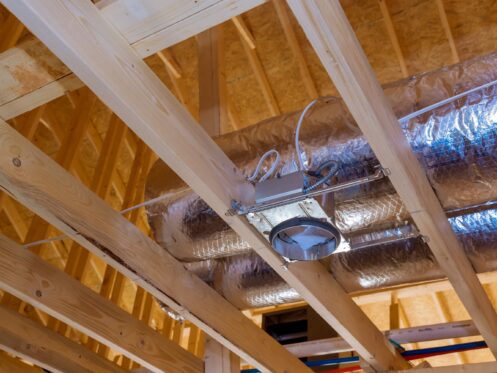When the humidity in your home is high, it will make it feel warmer than it actually is. As a result, you might use the air conditioner more than usual. This can translate into higher cooling costs and extreme wear on the AC. The high humidity can also increase the risk of mold and mildew, which can be hazardous to your home and health. Fortunately, there are lots of ways to target excess moisture in the air and improve indoor comfort.
Change the HVAC Filter Regularly
Your HVAC filter plays a large role in how clean the air is inside your house. When it’s dirty or clogged, it restricts airflow and causes the HVAC to work harder than normal. It also increases moisture problems by trapping damp air and reducing ventilation. This means you might notice musty odors or mold growth.
Keeping the filter changed is one of the best ways to help keep the humidity in check. We recommend filter replacements once every one to three months for regular HVAC setups. Ductless versions require filter changes once every two weeks.
Install a Whole-Home Dehumidifier
A whole-house dehumidifier might be the best option if your home is consistently stuffy. You can use this system in conjunction with your HVAC to remove excess moisture from the air. This technique reduces cooling costs, results in fewer allergy problems and improves comfort. More than that, it protects your house against mildew and mold. These two forms of moisture damage can be expensive to fix and dangerous to your health. Preventing them makes a big difference for improving indoor air quality.
Turn on Exhaust Fans
The purpose of exhaust fans in kitchens and bathrooms is to remove hot, humid air. You’ll need to keep those fans turned on while you’re using the stove or showering. After you’re done, leave them running for a little while longer. This removes the steam and humidity from your house rather than allowing them to accumulate. A small habit like this is a game-changer for indoor comfort.
Open the Windows During Pretty Weather
Opening windows is another way to target indoor humidity problems. It’s best to do this on days when the weather is cool or dry. The drafts blowing through the windows will circulate fresh air and lower moisture levels. This approach is only effective when the weather isn’t too humid, so be sure to check the forecast first.
Fix Plumbing Leaks
Water leaks are a major problem for indoor humidity levels. Even a small drip under a sink will add moisture to the air. Over time, the extra humidity will encourage mold and mildew, which can wreak havoc on furniture, flooring and walls. A good way to avoid this problem is to regularly check for leaks around sinks, toilets and water heaters. If you notice any wet spots, make sure to clean them up right away as you wait for a plumber to fix the leak. Look out for signs of hidden leaks like soft floors or water bill spikes, and call for professional leak detection to get them fixed ASAP.
Seal Doors and Windows
Humid air from the outside will seep into your house via gaps around doors and windows. As a result, maintaining a comfortable living space will be more of a challenge for your HVAC system. The extra work it has to put in will cause your energy bills to go up. The additional humidity that enters through the gaps will result in musty odors and increased mold growth. To stop these leaks, you can use weather stripping, sealant or door sweeps.
Improve Attic and Crawlspace Ventilation
Crawl spaces and attics are two of the most common places that tend to collect a lot of moisture. This is usually due to a lack of ventilation in these areas. The additional moisture can permeate your whole house if you don’t fix the ventilation problem. Excellent remedies for improving airflow in these spots include installing vents, fans or insulation. In addition to protecting your home’s structure against mold, this also makes it easy to control the relative humidity indoors.
Avoid Line-Drying Clothes Indoors
You might find it tempting to air-dry clothes inside your house, but this is never a good idea when dealing with excess humidity. As the clothes dry, they will release more moisture into the air. To avoid this, you can use a dryer or air-dry your clothes outdoors. If you must air-dry the clothes indoors, do it in a spot where you can open a window. This will allow the moist air to escape as the clothes dry.
Limit Steam-Producing Activities
Steam is a byproduct of cooking, bathing and the boiling of water. While these are commonplace tasks, doing them often or for an extended period of time may increase indoor humidity levels. To reduce steam, try covering pots when cooking, taking shorter or cooler showers and using exhaust fans. Simple changes like these make a big difference in controlling moisture.
Install a Heat Recovery Ventilator
The term “heat recovery ventilator” (HRV) refers to a machine that exchanges stale indoor air with fresh outdoor air. It does this without squandering energy, making it an excellent choice for houses that prioritize maximizing energy efficiency. Airtight homes also benefit greatly from HRVs. They maintain an even distribution of airflow, which prevents the buildup of condensation and humidity.
Close the Bathroom Door When Showering
Unless you take precautions, the steam from a hot shower will quickly disperse throughout your home. The moisture from the steam can lead to problems like mold growth and damaged paint. To contain the steam, just close the door to the bathroom while you shower. If there’s a window in the bathroom, keep it open until you’ve been out of the shower for a few minutes. This will allow all the moisture to leave the room through the window instead of going into other parts of the house.
Insulate Pipes and Walls
Condensation tends to occur the most on things with cold surfaces, like walls or exposed pipes. As it builds up, it can drip water and increase indoor humidity levels. One way to stop this from happening is to insulate the walls and wrap the pipes. One of our experts can help you choose the best types of insulation and wraps. Fiberglass insulation works great for walls and attics. Wraps made of foam perform extremely well for exposed pipes and water heaters.
Book Annual HVAC Maintenance
Scheduling annual HVAC maintenance is a key part of keeping indoor humidity levels in check. When the AC or heater has worn-out parts, it causes inefficient performance and increased energy consumption. As time passes, this inefficiency will lead to excess moisture in the air. You might notice condensation, mold growth or musty odors. With regular maintenance by a professional HVAC services team, your system can effectively regulate temperature and humidity. If you want, we can do maintenance on the AC in the spring and give the heater a tune-up in the fall. This ensures both systems are ready to perform at peak performance when you need them most.
Cozy Home Services is ready to help you improve your home’s indoor humidity levels. We offer HVAC tune-ups, water leak detection, water heater maintenance, and much more. Call Cozy Home Services today to schedule reliable HVAC services in Vacaville, CA.


